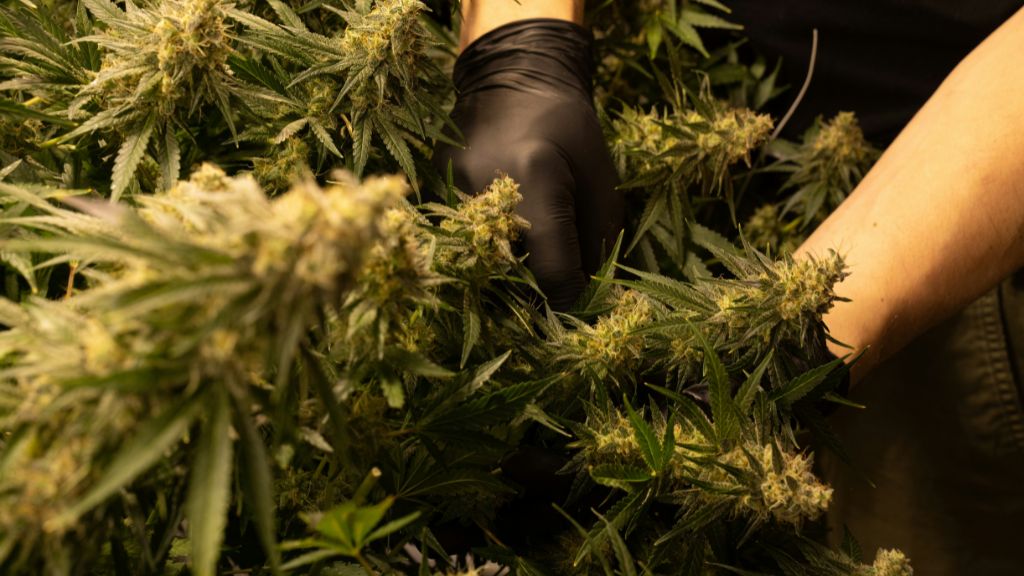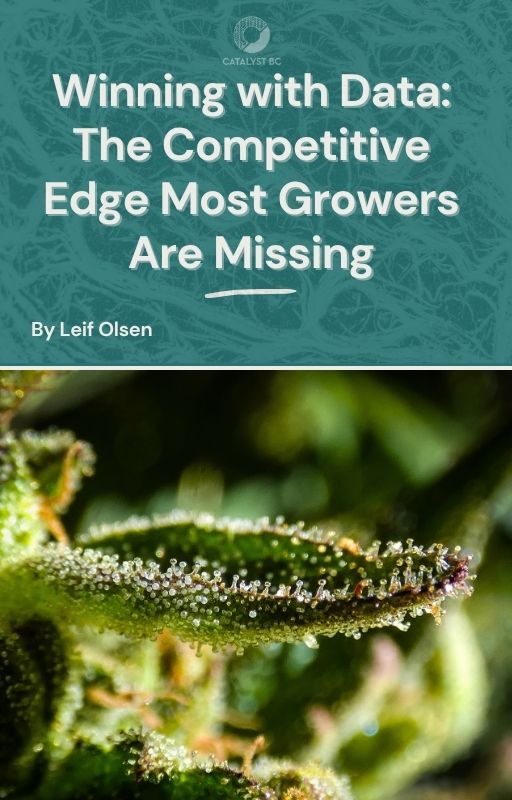Estimated reading time: 12 minutes
Table of contents
- Introduction
- The KPIs That Matter
- Facility Optimization: Start with the Basics
- Aligning Product Strategy with Market Demand
- Embracing Operational Efficiency
- Compliance Isn’t Optional—It’s Foundational
- Leveraging Technology and Data
- Culture and Talent Still Reign Supreme
- Your Role in Turnaround Success
- Final Thoughts: Cultivation as a Strategic Lever
- Cannabis Cultivation Turnaround Strategy FAQs
- Additional Resources
- Free eBooks For Cannabis Business Success
- Latest Articles
Cliff Notes: Cannabis cultivation turnaround strategies for stakeholders
Objective: Strategic guide to to turning around under-performing cannabis cultivation operations—enhancing efficiency, profitability, and long-term sustainability.
Key Components: Understand the key components to turn around a languishing cannabis cultivation business
- KPI Development & Data Clarity: Establishing and monitoring meaningful Key Performance Indicators (KPIs) like yield per square foot, cost per gram, and labor efficiency to diagnose problems and drive informed decisions.
- Facility Optimization: Improving operational flow, environmental control, and equipment usage—often through minor layout and workflow adjustments—without major capital expenditures.
- Market-Aligned Product Strategy: Aligning production with current consumer trends and sales data, rather than internal habits, to ensure sell-through and margin protection.
- Operational Efficiency: Eliminating process bottlenecks and waste by leveraging automation, SOP consistency, labor cross-training, and vendor evaluation.
- Compliance Culture: Embedding compliance into everyday operations through automation, SOP alignment with state regulations, and audit-readiness protocols.
- Technology Integration: Leveraging cultivation software, IoT sensors, and data dashboards to enhance environmental monitoring, scheduling, inventory, and predictive analytics.
- Workplace Culture & Leadership: Building an engaged, accountable team culture through leadership modeling, cross-functional communication, and internal career growth pathways.
- Executive Engagement: Encouraging leadership to prioritize cultivation success with clear performance goals, data dashboards, and active involvement in team alignment and strategic direction.
Catalyst BC supports cannabis operators through every stage of the cannabis cultivation turnaround journey—combining technical assessments, team development, and strategy alignment to transform cultivation operations into high-performing assets.

Introduction
Creating a profitable cannabis cultivation business is far more complex than simply growing plants—it’s about managing a company within one of the world’s most dynamic and tightly regulated industries. Operators often find themselves battling shrinking margins, ever-changing compliance requirements, and increasing competition, all while trying to extract maximum value from every corner of their operation.
This is where a well-structured turnaround or optimization plan can be the difference between chasing losses and achieving sustainable, predictable returns. Below, we explore the high-level strategies that matter most for executives aiming to improve—or rescue—under-performing cannabis cultivation operations without diving too deep into technical weeds.
The KPIs That Matter
Understanding and actively managing the right metrics is the cornerstone of any successful cannabis cultivation turnaround. KPIs (Key Performance Indicators) help you benchmark performance, diagnose inefficiencies, and prioritize investments. But in many operations, these numbers are tracked inconsistently—or worse, not at all.
Start with yield per square foot and cost per gram, two of the most fundamental indicators of production efficiency. Add to that labor utilization rates, energy consumption per cycle, crop loss percentage, and average selling price per SKU. Together, these metrics paint a comprehensive picture of your operation’s health.
The key is context and comparison. How does your cost per gram compare across different grow rooms? Are certain cultivars consistently under-performing in yield or potency? Is labor being deployed evenly across shifts? These aren’t just numbers—they’re signals.
By reviewing trends, you can identify not only what’s broken but also what’s working. That allows you to replicate success, reallocate resources, and confidently test new ideas. More importantly, data-driven decision-making makes your business more resilient and agile in the face of market volatility.
At Catalyst BC, we help operators establish baselines and define meaningful KPIs tailored to their business model and facility footprint. We create custom dashboards and reporting tools that empower leadership teams to steer their cultivation ship with precision and foresight.
Facility Optimization: Start with the Basics
Before investing additional CapEx in mechanical systems or overhauling your SOPs, take a step back and assess the fundamentals. Is your facility achieving and maintaining optimal environmental setpoints? Is layout enabling smooth, repeatable workflows—or are these in need of optimization?
Facilities are often designed without appreciation for the nuance of cannabis propagation and operator input, resulting in wasted labor, cross-contamination risks, or inefficient airflows. Re-evaluating your facility through the lens of operational efficiency can reveal dozens of minor improvements that compound into significant gains.
Consider the following areas:
- HVAC and climate control: Are your grow rooms maintaining stable temperature and humidity within optimal ranges in dark, light, and transition periods? What’s your recovery time after a door is opened or irrigation occurs?
- Lighting strategy: Are you using legacy fixtures that consume unnecessary electricity, or have you transitioned to efficient LED systems with adjustable spectrums?
- Storage and material flow: Are your nutrients, PPE, and equipment stored in easily accessible locations? Are you wasting labor time moving items across the facility?
- Post-harvest flow: Are your trimming, drying, and packaging areas designed for throughput, or are they a bottleneck?
Even minor layout changes can drive significant labor savings and throughput gains. Our team at Catalyst BC offers facility audits that reveal optimization opportunities without the need for major construction or CapEx.
Aligning Product Strategy with Market Demand
A common mistake in under-performing cultivation businesses is pushing product to market based solely on internal capabilities—not consumer demand. While it’s tempting to double down on what your team is good at growing, that strategy can backfire in a rapidly maturing industry.
You need a product strategy informed by data—not just from your shelves but from the market at large. Which product formats are growing fastest in your state? What terpene profiles are currently resonating with wellness consumers? Is the hype around specific genetics translating into sell-through velocity or just shelf ornamentation?
Effective cultivation teams work closely with marketing, wholesale, and retail operations. They maintain a production plan or roadmap based on sales feedback, margin analysis, and consumer trends. They also trial new genetics in R&D rooms and retire under-performing SKUs without ego.
For multi-state operators (MSOs), consistency across markets is critical—but local differentiation matters too. Your Florida customers may prefer effects-based packaging, while your Michigan base is chasing boutique strains in living organic soil (LOS) with limited drops.
Catalyst BC supports operators with go-to-market alignment services, helping cultivation teams build compelling portfolios that are not only commercially viable but also profitable. Our strategies ensure your grow rooms produce what people want to buy.
Embracing Operational Efficiency
Operational bloat is one of the most common causes of lagging profitability—overstaffing, redundant tasks, and outdated processes all chip away at margins already under pressure.
But operational efficiency isn’t about running skeleton crews—it’s about doing more with your existing resources. It’s about using data and automation to empower human effort, not replace it.
Key areas to examine:
- Labor utilization: Are your trimmers working at capacity or standing idle between shifts? Are cultivation techs cross-trained to support post-harvest during slower cycles?
- Process automation: Have you automated irrigation, fertigation, and environmental monitoring—or are team members still logging data by hand?
- Standard operating procedures: Are your SOPs up to date, and are they being followed consistently across rooms and shifts?
- Vendor contracts: Are you overpaying for consumables, packaging, or outsourced testing?
Improving operational efficiency isn’t a one-time project—it’s a cultural shift. We help operators establish continuous improvement programs, using lean principles and workflow audits to reduce costs without compromising quality.
Compliance Isn’t Optional—It’s Foundational
No matter how beautiful your flower is or how efficient your facility is, none of it matters if your license is at risk. In cannabis, compliance is both a floor and a ceiling—it protects your business while defining the upper limits of what you can do.
The most successful operations don’t view compliance as a burden—they design for it. From automated METRC integrations to QR-coded batch tracking and SOPs that match state requirements word-for-word, compliance becomes baked into daily operations.
Common pitfalls include:
- Missing or delayed METRC entries
- Incomplete chain of custody on harvests or transfers
- Labeling and packaging discrepancies
- Insufficient documentation for waste disposal
- Lack of employee training records
The cost of non-compliance goes far beyond fines, including recalls, shutdowns, lost customer trust, and brand damage. Catalyst BC helps operators establish a culture of compliance with systems that alert—not just react—when something goes off-track.
We’ve developed audit-readiness playbooks, automated workflows, and training protocols to ensure your operation can withstand any inspection—announced or unannounced.
Leveraging Technology and Data
Technology alone won’t fix an under-performing cultivation business—but when deployed strategically, it amplifies everything you do right.
Cultivation software platforms can unify scheduling, inventory, task management, and environmental tracking in one place. IoT sensors can provide minute-by-minute feedback on temperature, VPD, CO2, and light intensity—allowing proactive corrections.
AI and machine learning also enter the conversation, offering predictive insights based on historical data. Imagine a system that can flag pest outbreaks before they happen or predict yield outcomes based on environmental trends.
The key is integration. If your tech stack doesn’t talk to itself or your team, it becomes noise. We help clients select and integrate tech platforms that fit their scale, budget, and workflow preferences, ensuring data becomes a strategic asset, not a digital headache.
Culture and Talent Still Reign Supreme
The best systems and technologies in the world won’t matter if your team is disengaged or misaligned. Cultivation is a people-powered business. It also requires a culture that values accountability, communication, and pride in the product.
Common signs of culture drift include:
- High turnover and burnout
- Inconsistent practices between shifts or rooms
- Blame-shifting or lack of ownership
- Poor communication between departments
To reverse this, leaders must model the culture they want to create. They must celebrate successes and failures and make space for team-driven problem-solving. They must also build career pathways for cultivators and give them the tools and support to grow into leads, trainers, or even product development roles.
Catalyst BC offers leadership coaching, culture audits, and team-building frameworks to strengthen the people side of your operation. Because plants don’t grow themselves at the end of the day—people do.
Your Role in Turnaround Success
As an executive, stakeholder, or operator, your job isn’t to micromanage every nutrient mix or lighting cycle—it’s to create the conditions for success. That starts with clarity.
You need a clear vision of success—whether 100+ grams per square foot, 20% margin improvement, full vertical integration, or operational readiness for expansion. You need KPIs that track toward those goals. And you need a team that is resourced, aligned, and accountable.
Turnarounds succeed or fail based on executive engagement. That means regular performance reviews, cross-functional meetings, and a bias toward action. Your involvement signals that cultivation is not just an operational concern—it’s a strategic priority.
We work with leadership teams to establish executive-level reporting dashboards, quarterly OKRs (Objectives and Key Results), and accountability structures that drive tangible outcomes.
Final Thoughts: Cultivation as a Strategic Lever
An under-performing cultivation operation doesn’t have to be a liability. It can become your company’s strongest asset with the right strategies and support.
Whether you’re trying to stabilize a struggling facility, prepare for M&A activity, or build a blueprint for multi-site expansion, the fundamentals remain the same: precise data, efficient workflows, airtight compliance, market-aligned product strategy, and an engaged team.
At Catalyst BC, we specialize in helping operators turn cultivation challenges into competitive advantages. Our clients don’t just survive—they scale, optimize, and lead.
Ready to take your cultivation operation to the next level? Let’s talk 303-305-3787.
Contact Catalyst BC to schedule a consultation and learn how we can help optimize your cannabis cultivation business for sustainable success.
Cannabis Cultivation Turnaround Strategy FAQs
A cultivation turnaround strategy involves identifying operational inefficiencies and restructuring grow operations to improve performance, profitability, and compliance.
Key KPIs include yield per square foot, cost per gram, labor utilization, energy usage, crop loss percentage, and average selling price per SKU.
Simple changes in layout, material flow, lighting upgrades, and airflow improvements can lead to major gains in efficiency without costly renovations.
Producing what the market actually wants increases sell-through rates, protects margins, and reduces waste from unsold SKUs or irrelevant genetics.
It means maximizing productivity with your existing team through automation, SOP consistency, labor cross-training, and vendor contract evaluation.
Automated tracking, audit-ready SOPs, employee training records, and robust documentation help maintain licensing and regulatory compliance.
Tech platforms consolidate data across tasks, environment, inventory, and more—enabling proactive decisions, predictive analytics, and scalable operations.
A strong culture reduces turnover, increases accountability, improves team alignment, and drives long-term success through empowered employees.
Catalyst BC provides data-driven assessments, facility audits, leadership coaching, and custom optimization plans tailored to each client’s needs.
If you’re facing low margins, compliance issues, high turnover, or inconsistent performance, it’s time to reevaluate and rebuild your operational strategy.
Additional Resources
Free eBooks For Cannabis Business Success
Latest Articles
- Cannabis 280E Compliance and COGS Optimization Expert StrategiesThe cannabis industry operates under a unique federal tax burden imposed by Internal Revenue Code (IRC) §280E. While state legalization has flourished, this provision, which denies deductions for ordinary business expenses of trades dealing in controlled substances, remains the single greatest threat to cannabis profitability.
- Owner’s Rep for Cannabis Dispensary Buildout: Expert Compliance & Project ManagementNavigating the highly-regulated world of a cannabis dispensary buildout requires specialized expertise beyond standard construction. The complexity of securing a final operating license, controlling costs, and preventing opening delays for a cannabis dispensary hinges on professional guidance. This is why securing an experienced Owner’s Rep for Cannabis Dispensary Buildout is a critical first step.
- The Indispensable Owner’s Rep for Cannabis Cultivation Facility Buildout: Expert Project Management to Prevent Cost OverrunsIn this high-stakes arena, the Owner’s Rep for Cannabis Cultivation Facility buildout is the crucial strategic partner. They are the expert professional who ensures the owner’s vision is translated into a successful, operational, and profitable reality.
- Cannabis Dispensary Compliance: Training, Inventory & ProfitabilityIn today’s regulated cannabis market, cannabis dispensary compliance is not optional—it is the foundation of a sustainable and profitable retail business. Every dispensary, from boutique shops to multi-state operators, must follow strict dispensary regulatory compliance standards, maintain accurate cannabis inventory management systems, and invest in ongoing cannabis dispensary training programs.
- Beyond Compliance: Implementing a Cannabis Dispensary Secret Shopper ProgramAs a cannabis retail owner, you operate in a high-stakes environment where federal prohibition meets state-regulated commerce. Your retail floor is not just a sales hub—it’s a constant target for mandatory inspection and the front line for brand differentiation. The most critical tool for navigating this complex reality is the professional, recurring Cannabis Secret Shopper program.
- Architects of the Cannabis Industry: What Defines An Expert Canna Consultant?An expert Canna Consultant is the strategic architect and operational engineer of a cannabis venture. They are specialized cannabis industry consultants who translate ambiguous legislation into profitable business processes.











